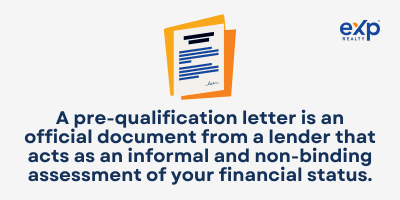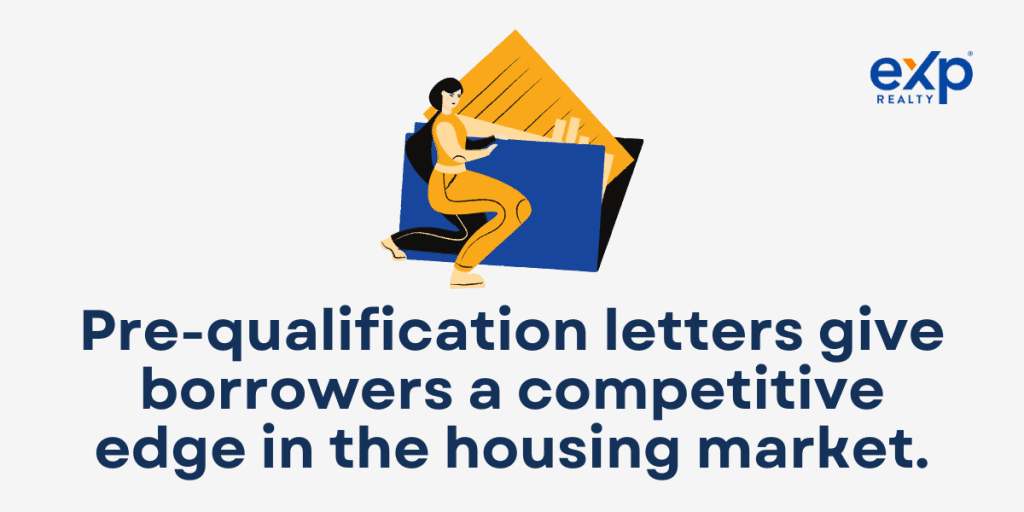Buying a home can seem complicated, especially for first-time homebuyers. As part of your house-hunting journey, you may come across a term like a pre-qualification letter. So just what is a pre-qualification letter, and how does it assist you in buying a home?
This article will explain everything you need to know about this letter and its significance in home buying. After you’ve read it and have learned about these financial documents, you can browse some of our available homes for sale.
What Is a Pre-Qualification Letter?
It is an official document from a lender that acts as an informal and non-binding assessment of your financial status. In these letters, lenders state that they would give you a mortgage loan.

A pre-qualification letter is based on the information you voluntarily provide to the lender, which doesn’t usually involve any verification process. Therefore, while it gives an initial understanding of your borrowing power, its accuracy depends on how precise and honest you are with the provided financial details.
Moreover, a pre-qualification letter can vary from lender to lender. Financial institutions might provide varied estimates based on their policies, evaluation criteria, and lending standards. Therefore, it’s beneficial to shop around and obtain pre – qualification letters from multiple lenders to understand your potential loan amount comprehensively.
So what’s the difference between a pre-approval letter and a pre-qualification letter? Well, pre-approval letters are often a step ahead in the loan application process.
Unlike pre-qualification, pre – approval letters are based on verified financial data and are considered more reliable. In the pre-approval process, the lender performs a hard check on your credit history and financial standing, thereby more accurately determining what kind of mortgage you can manage. However, a pre-approval letter is still not a guarantee of loan issuance; it remains subject to the property’s appraisal and other potential contingencies.
Remember, even though a pre-qualification letter is a useful first step, it doesn’t replace the need for a more concrete pre-approval later on. Because it’s based on non-verified financial data you provide, it’s less reliable than a pre-approval.
Once you understand your budget better and are ready to start the home-buying process in earnest, aim to get pre-approved for a mortgage to strengthen your position as a buyer. Neither a pre-qualification nor a pre-approval letter constitutes a final loan commitment. After an underwriting process, final loan approval comes after you’ve chosen a specific home to purchase.
Why Is a Pre-Qualification Letter Important?
These letters give borrowers a competitive edge in the housing market. In a seller’s market where multiple offers are common, a pre-qualification letter signals to sellers that you’re serious about buying. While these letters are not guaranteed loans, they can place you in a favorable position against other potential buyers who haven’t taken this step.

Pre-qualification letters also offer an opportunity for early dialogue with lenders. Engaging with a lender early in your home-buying journey can help you understand different mortgage options, interest rates, and terms. It also provides a chance to discuss potential hurdles and solutions related to your mortgage application.
For those planning to refinance their current mortgage, a pre-qualification letter helps identify whether this is a financially viable move. By assessing your financial situation, a lender can guide you on the potential benefits or drawbacks of refinancing, given your current circumstances.
So, while a pre-qualification letter doesn’t assure you of a mortgage, it is an important stepping stone in home buying. It helps you understand your financial picture better, streamlines your home search, and puts you in a stronger position when negotiating a home purchase.
Furthermore, a pre-qualification letter can guide you in making necessary financial adjustments. For instance, if the pre-qualified loan amount falls short of the property price range you’re targeting, you could consider strategies such as paying down debts, increasing your savings for a larger down payment, or seeking additional income sources.
If you qualify for a larger loan than expected, remember not to stretch your budget just because you can. Buying a more expensive home might lead to financial strain in the future. Always consider your comfort level with potential mortgage monthly payments and other homeownership expenses.
How To Get a Pre-Qualification Letter

Obtaining a pre-qualification letter is a straightforward process. It involves gathering your financial information, reaching out to lenders, and providing the necessary details for evaluation. Here’s a step-by-step guide on how it’s done:
Gather Financial Information
The first step in the loan process is to collect your financial details, as the lender will use this information to determine your potential mortgage options. Start by collecting documents that highlight your income, expenses, and assets. These may include pay stubs, tax returns, bank statements, and investment statements. Be prepared to disclose details about any ongoing financial commitments, such as auto loans, credit card debts, and student loans.
In addition to your income, debt, and asset details, prepare information on your monthly expenses, like utilities, groceries, and entertainment. This comprehensive overview will give the lender a better picture of your financial health and ability to manage mortgage payments in your overall budget.
When you’re gathering your financial information, it can also be helpful to include any information and additional documentation related to your credit history. For example, if you’ve recently cleared off a significant debt or improved your credit score substantially, evidence of these changes could positively influence your pre-qualification process.
Contact a Lender
The next step is to reach out to a mortgage lender. It’s advisable to contact multiple lenders to compare the terms and find the most favorable loan program for your situation.
Every lender may offer different interest rates and loan terms, so shopping around can help you secure the best deal. Discuss your financial situation openly to obtain the most accurate pre-qualification letter.
While communicating with lenders, ensure you understand all the requirements for the pre-qualification process. Ask about their assessment criteria, the estimated timeline, any fees, and how long the letter will be valid. This way, you’ll have a clearer idea of what to expect and can prepare accordingly.
Don’t shy away from asking questions when you’re interacting with lenders. If there are terms or aspects you don’t understand, ask for clarification. Knowing these borrower guidelines can be very helpful.
Remember, lenders are assessing your financial health and your understanding of the process and the potential obligations. Showing that you’re informed and proactive can leave a positive impression on lenders.
Provide Necessary Information
After selecting a lender, you’ll need to provide your financial information. This includes details about your employment status, monthly income, total debt, bank statements, credit score, and the desired loan amount.
Self-employed borrowers will have to provide copies of their business tax returns. The lender may also check soft credit to understand your credit history better. Rest assured, this credit check won’t affect your credit scores.
When providing your financial information, be as transparent as possible. If there are any irregularities in your financial history or income, make sure to discuss these with your lender. It’s better to address any potential issues upfront rather than have them discovered later in the process, which could delay or jeopardize your loan approval.
Lenders might provide a list of borrowers’ expectations, which are conditions you must meet before pre-approvals. These can include closing certain accounts or paying off outstanding debts.
In providing necessary information, remember that this initial exchange with your lender sets the stage for future interactions. Maintaining honesty and transparency from the beginning will aid in the process and foster a relationship of trust with your lender, which can be beneficial as you navigate the remainder of the home-buying journey.
Receive Pre-Qualification Letter
Upon reviewing your financial situation, the lender will provide a pre-qualification letter. This document will estimate the loan amount you may qualify for based on your financial situation. Remember, a pre-qualification letter doesn’t guarantee mortgage approval but is an important step in home-buying.
Once you receive this letter, carefully review it for any inaccuracies or misunderstandings. If you find anything you believe to be incorrect or your financial situation changes, contact your lender immediately for a revised letter.
Remember that while a pre-qualification letter is a positive step towards homeownership, it doesn’t necessarily mean you’re ready to start making home offers. Instead, use this document as a guide during the initial house-hunting stages to help narrow your search. It’s essential to continue saving, improving your credit score, and preparing for the next steps in the mortgage process.
Shop for a Home
When you receive your pre-qualification letter, you’re ready to embark on your house-hunting journey. The letter guides your search, ensuring you focus on homes within your budget. As you browse, inform your real estate agent about your pre-qualified status and price range. They can help you find properties that match your preferences and financial ability.
As you shop for a home, remember that a pre-qualification letter doesn’t commit you to a particular lender. You still have the freedom to explore and compare loan offers from different lenders once you’re ready to proceed with the loan application. Your pre-qualification letter can be a benchmark, helping you evaluate if other offers align with your pre-qualified amount and terms.
Key Takeaways
A pre-qualification letter is essential for prospective homebuyers in the United States. This document is an estimate from a lender showing how much you might be eligible to borrow for a mortgage based on your financial situation. It differs from a pre-approval letter, a more concrete commitment from a lender subject to underwriting and other conditions.
In real estate’s competitive market, getting pre-qualified offers numerous benefits. It clarifies your price range, thus streamlining the home-buying process and making it less stressful. For sellers, seeing a pre-qualification letter from potential buyers can be reassuring, indicating the buyer’s serious intention and financial readiness.
Remember, the path to homeownership is an exciting journey. Besides the pre-qualification letter, seeking the help of an experienced real estate agent can make this journey smoother and more successful.
If you’re ready to start searching for your dream home, visit eXp Realty and sign up to get alerts of new listings and find an experienced local eXp agent to guide you in your search.
FAQs: What is a Prequalification Letter
Still want to know more about pre-qualification letters? Here we answer some of the most commonly asked questions about these documents.
What is the difference between a preapproval letter and a prequalification letter?
A pre-qualification letter is an initial estimate of how much you might be eligible to borrow. In contrast, a pre-approval letter is a more solid commitment from a lender, subject to final approval.
What does your pre-qualification mean?
Pre-qualification means a lender has assessed your financial situation and determined an estimated loan amount you might qualify for when seeking a mortgage.
Can you make an offer with a pre-qualification letter?
Yes, you can make an offer with a pre-qualification letter, and it often strengthens your offer by demonstrating your financial readiness.
Is it better to be prequalified or pre-approved?
Preapproved is generally seen as better because it’s a more concrete commitment from a lender, but both can benefit the home-buying process.
Can you be denied a loan after pre-approval?
Yes, a loan can still be denied after pre-approval if the underwriting process reveals issues such as changes in your financial situation, or if the property doesn’t meet the lender’s criteria.
Does pre-qualification run your credit?
Generally, pre-qualification involves a soft credit check, which doesn’t impact your credit score. However, pre-approval requires more involved credit reports, including a hard credit check which can affect credit scores.
How long does a prequalification letter last?
Typically they last for 60 to 90 business days. However, this can vary by lender and financial situation, so it’s best to check with your lender.
What documents are needed for prequalification?
Typically, you must provide information about your monthly income, assets, debts, and credit. That may include pay stubs, bank statements, tax returns, and a record of your debts.
Lenders may also require additional documents or information to better understand your financial standing. These could include letters explaining any credit issues, proof of other income sources such as alimony or child support, or records of recent significant financial transactions. Be prepared to provide this additional information if necessary.





